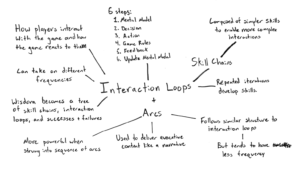Here’s my sketchnote:

One of the games that I keep finding myself coming back to is Terraria. Terraria is similar in structure to its more popular cousin Minecraft — both are action-adventure sandbox games. However — in my opinion — Terraria’s structure creates a greater focus on the “action” part of action-adventure.
At its core, Terraria can be divided into a string of interaction loops and arcs — it is this tree-like sequence-structure that gives Terraria its addictiveness and replayability. At every point in the player’s journey, there is a new boss that poses a challenge within the gameplay. These bosses are appropriately designed to match the player’s skillset and resources at every step of the game. At the same time, they are each so radically different from the previous bosses and thus provide new challenges and new rewards to entice the player’s curiosity. These boss provide the “arcs” that span the interaction loops of Terraria.
The interaction loops are defined by what the player does between boss fights — in particular, these loops are defined by the “grind”. In order to step up to the challenge of a new boss with added difficulty, players must engage in the reoccurring loop of mining, crafting, combat, and exploration in order to level-up their resources. Through these reoccurring loops, they develop new skills to make use of more powerful weapons and advance their knowledge of the game mechanics.


